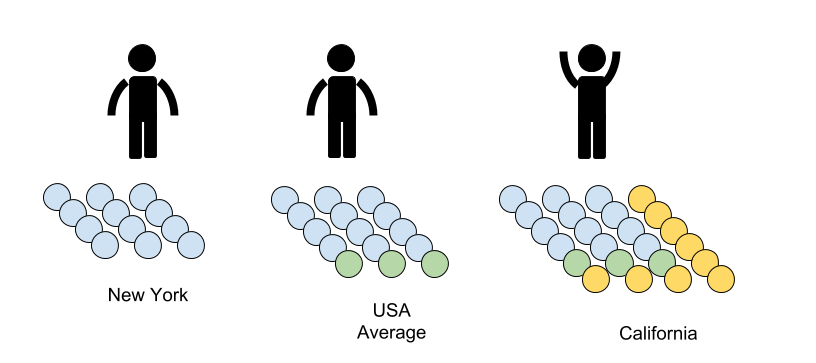
There's a limit to the amount of time and attention a teacher can give each student in their care. Class sizes vary dramatically among schools in different states and districts. It probably matters.
In This Lesson

How is class size measured?
Does California have big class sizes?
Does class size matter?
Are smaller class sizes better?
What steps have been made to decrease class size in California?
Should class sizes vary, and when?
What is the ideal class size?
▶ Watch the video summary
★ Discussion Guide
Class size in school systems is measured by the student-teacher ratio. In a small class there is more teacher-time available because it's allocated among fewer students. One strategy for improving educational quality is to hire more teachers, which lowers the student-teacher ratio. This lesson summarizes the arguments for and against making this change
California class sizes are huge
Compared to other states, class sizes in California are abnormally big.

Large class sizes, measured by comparing the number of students to the number of teachers on staff, are nothing new for California. The graph below shows the average student-teacher ratio in each state since 1970. In 2020, California ranked senond worst in the country for its student-to-teacher ratio in public schools, with 22.7 students per teacher.
The student-teacher ratio is used as a proxy for class size, but it isn't quite the same thing. Most actual class sizes are larger than this statewide benchmark because not all certified teachers at a school work in classes all day. Still, it is safe to say that the higher the number of students per teacher in a state in any given year, the larger class sizes must be, and vice versa.
Clearly, smaller classes cost more than big ones. But does it make a difference?
Smaller class size is better, but...
Like anything in social sciences, context matters. If all teachers were equally effective, then it would be obious: smaller class sizes are better. But teachers aren't all the same. Some thrive even with a large class. Other teachers struggle with larger classes, but might do better with smaller ones.
Research suggests that, on average, class sizes matter, especially in early grades and for disadvantaged students. But multi-national research by the Organization for Economic Cooperation and Development (OECD) concludes that other strategies for improvement might be better: "Overall, evidence on the effects of reduced class size on student performance is weak."
Virtually all research about class size finds that minor changes in the student-teacher ratio make no measurable difference. It’s not like a magic dial that immediately delivers better learning results with little adjustments. But California's class sizes are dramatically larger than those in most other states.
...the greatest benefits accrue for disadvantaged students in grades K-3, and when there are 18 or fewer students per teacher.
From the perspective of student outcomes, an ideal approach would optimize for classroom effectiveness, varying the size of classes according to how well individual teachers can accommodate them. This is a very difficult policy to put into a contract, though.
Class Size Matters, an advocacy organization, provides additional information and research on class sizes, including cost-benefit analyses.
Unintended consequences
In 1988, California voters passed Proposition 98, which required the California legislature to increase spending on public education. Then-governor George Deukmejian, who had opposed Prop 98, argued that a sudden influx of money would change nothing if it merely raised teacher salaries. As an alternative, he argued that the money should be invested in reducing class sizes for grades K-3, capping class size at twenty students.
This policy change had a strong basis in research, but it turned out badly. Implemented without a phase-in period, the mandate to reduce class sizes prompted a sudden boom in demand for K-3 teachers. As school districts rushed to fill the new teaching positions, experienced teachers had lots of schools to choose from. Unsurprisingly, they tended to choose positions in schools and districts that offered the best salaries and working conditions.
Schools serving low-income communities, meanwhile, had a hard time attracting qualified candidates. Smaller class sizes backfire if schools are forced to hire worse instructors. This disruption had a long-lasting and unequal impact on California's schools. It serves as a cautionary tale for education reform: beware unintended consequences.
The California Department of Finance estimates that the state spent over $22 billion on incentives for K-3 class size reduction from the program’s inception until it was changed in 2009-10. In the lean budget years leading to 2013, the incentives were reduced and the rules effectively eliminated. Elementary class sizes rose steadily as a result.
The Local Control Funding Formula, which defines how the state allocates funds to school districts, includes an incentive for districts to keep K-3 class sizes below 24 students. (Learn more about LCFF in Lesson 8.5)
Should classes vary in size?
In virtually any school, the number of students in each class tends to be pretty uniform. Walk into two 4th grade classrooms in a school district at random, and the number of students will probably vary little. Is this uniformity a mistake? Should classes vary in size?
Under the Local Control Funding Formula, which provides extra money for high-need students, local school districts have the power to vary class sizes if they want to, for example by reducing class sizes in schools that serve the highest proportions of low-income students or English learners. Research undertaken for the Getting Down to Facts II project identified this as a promising practice.
School time varies a great deal among the states and around the world. The next lesson, 4.3: School Hours, takes up the question of how much time students spend learning.
This lesson was updated in November 2023.
CHAPTER 4:
Spending Time...
-
Spending Time...
Overview of Chapter 4 -
Preschool and Kindergarten
Yes, Early Childhood Education Matters -
Class Size
How Big Should Classes Be? -
School Hours
Is There Enough Time To Learn? -
Time Management in School
Spending Time Well -
Tutoring
When Kids Need More Time and Attention -
Summer School
Time to Learn, or Time to Forget? -
After School Learning
Extending the School Day -
Attendance
Don't Miss School!
Related
Sharing is caring!
Password Reset
Search all lesson and blog content here.
Login with Email
We will send your Login Link to your email
address. Click on the link and you will be
logged into Ed100. No more passwords to
remember!














Questions & Comments
To comment or reply, please sign in .
Carol Kocivar June 13, 2022 at 8:28 pm
Kindergarten—average class size not to exceed 31 students; no class larger than 33 students
Grades one through three—average class size not to exceed 30 students; no class larger than 32 students
Grades four through eight—in the current fiscal year, average number of students per teacher not to exceed the greater of 29.9 (the statewide average number of students per teacher in 1964) or the district’s average number of students per teacher in 1964
Sheila Melo May 29, 2020 at 11:03 am
Jamie Kiffel-Alcheh November 2, 2019 at 9:32 pm
That is not actually what it says above. It says 18 or fewer students per teacher. If a classroom has more than one teacher in it, does that not keep the ratio?
Janvi Singh January 31, 2021 at 10:49 pm
Carol Kocivar January 14, 2018 at 9:18 am
Its introduction enticed more families who would have sent their children to private school to enroll in public school. " Their presence resulted in higher average test scores, but also helped improve their classmates’ performance as well, the authors said."
Article in:
The 74
Irma Aldana May 31, 2017 at 7:14 pm
How does this make sense?
Carol Kocivar June 22, 2016 at 11:32 am
A June 2016 policy brief from the National Education Policy Center takes another look at the research and finds....
"Despite claims to the contrary by some policymakers, Mathis concludes that reduction in class sizes may prove the most cost-effective school improvement policy overall. In Mathis’ view, money saved today by increasing class sizes will likely result in additional substantial social and educational costs in the future."
Dr. Mathis is Managing Director of the National Education Policy Center.
http://nepc.colorado.edu/publication/research-based-options
francisco molina August 13, 2019 at 3:17 am
Albert Stroberg May 1, 2016 at 7:12 pm
asoltero March 2, 2016 at 2:13 pm
iemailjillian February 29, 2016 at 5:39 pm
Angelica Manriquez February 29, 2016 at 3:53 pm
Will Kimbley February 5, 2016 at 12:24 pm
The reason is the research shows that by and large teachers do not teach any differently with a smaller class size than with a larger class. If a teacher does not take advantage of the smaller class size to change the way they teach, it is not going to have much effect.
http://visible-learning.org/hattie-ranking-influences-effect-sizes-learning-achievement/
KimS September 15, 2015 at 10:27 am
When a school designs this as an integral part of its pedagogy, that works. But when it is forced on schools for logistical reasons of budget, the kids and teachers suffer. My kids go to an IB school that's designed as an age-appropriate, sequentially-building program. Combo classes are causing parental worry and a lot of time and effort for the teachers in both classroom management and curriculum re-designs.
I don't think this is what the LCFF lower class size mandate intended to do, and nobody seems to be tracking whether the class sizes are combos or not. It's a huge loophole in the law.
Tara Massengill April 28, 2015 at 2:13 pm
aimeef23 April 27, 2015 at 4:08 pm
cnuptac March 22, 2015 at 2:55 pm
Mamabear March 19, 2015 at 11:37 pm
Brandi Galasso February 22, 2015 at 7:48 pm
David B. Cohen April 7, 2011 at 11:00 pm
I find it curious that you offer words of caution about unintended consequences for those who want to reduce class sizes, but express no caveats about the opposite argument. I find it troubling that you pass along Bill Gates opinions on education so uncritically despite his lack of credentials in the field and his increasingly obvious agenda in edreform, which many of us in the classroom find increasingly alienating and even hostile.
Steven N June 23, 2014 at 5:40 pm